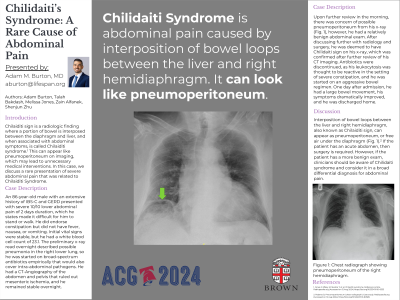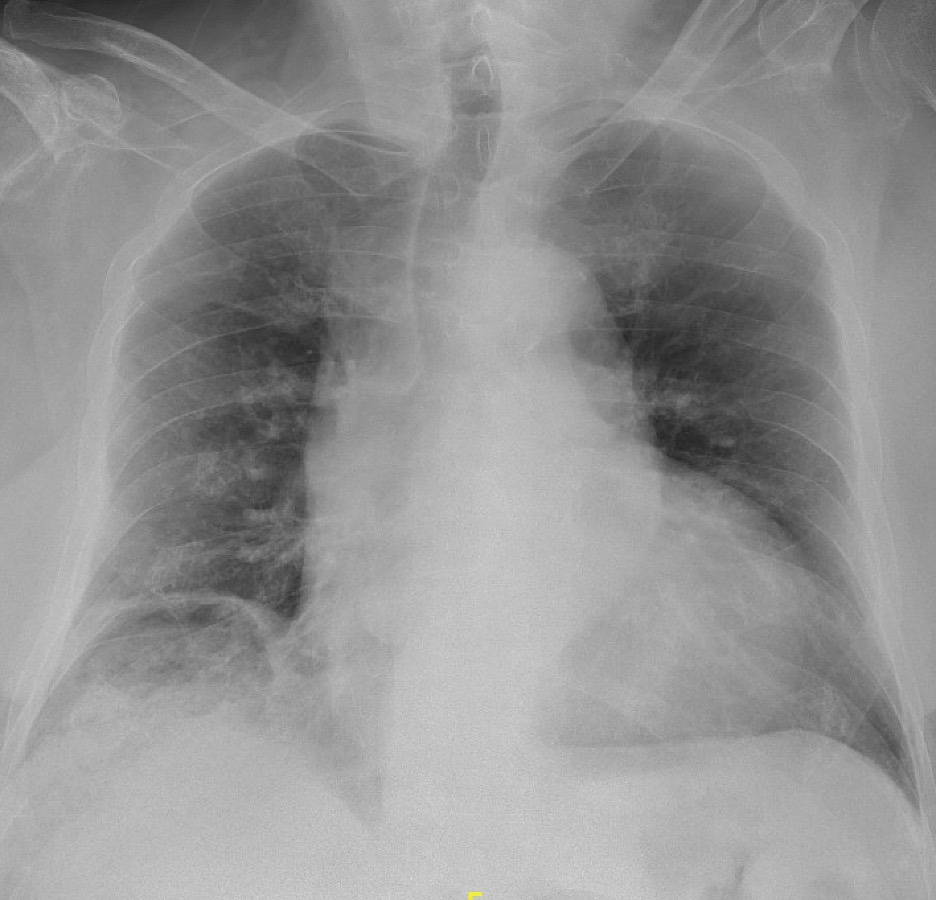Sunday Poster Session
Category: Functional Bowel Disease
P0647 - Childaiditi’s Syndrome: A Rare Cause of Abdominal Pain
Sunday, October 27, 2024
3:30 PM - 7:00 PM ET
Location: Exhibit Hall E

Has Audio
.jpeg.jpg)
Adam M. Burton, MD
Brown Medicine/Lifespan
Providence, RI
Presenting Author(s)
Adam M. Burton, MD1, Talah Bakdash, MD2, Melissa Jones, MD3, Zain Alfanek, MD2, Shenjun Zhu, MD3
1Brown Medicine/Lifespan, Providence, RI; 2Brown University / Rhode Island Hospital, Providence, RI; 3Brown University / Lifespan Physician Group, Providence, RI
Introduction: Chilaiditi sign is a radiologic finding where a portion of bowel is interposed between the diaphragm and liver, and when associated with abdominal symptoms, is called Chilaiditi syndrome. This can appear like pneumoperitoneum on imaging, which may lead to unnecessary medical interventions. In this case, we discuss a rare presentation of severe abdominal pain that was related to Chilaiditi Syndrome.
Case Description/Methods: An 86-year-old man with an extensive history of IBS-C and GERD presented with severe 10/10 lower abdominal pain of 2 days duration, which he states made it difficult for him to stand or walk. He did endorse constipation but did not have fever, nausea, or vomiting. Initial vital signs were stable, but he had a white blood cell count of 23.1. The preliminary x-ray read overnight described possible pneumonia in the right lower lung, so he was started on broad-spectrum antibiotics empirically that would also cover intra-abdominal pathogens. He had a computed tomography-angiography of the abdomen and pelvis that ruled out mesenteric ischemia, and he remained stable overnight.<br><br><br><br><br>Upon further review in the morning, there was concern of possible pneumoperitoneum from his x-ray (Figure 1), however, he had a relatively benign abdominal exam. After discussing further with radiology and surgery, he was deemed to have Chilidaiti sign on his x-ray, which was confirmed after further review of his computed tomography imaging. Antibiotics were discontinued, as his leukocytosis was thought to be reactive in the setting of severe constipation, and he was started on an aggressive bowel regimen with bisacodyl suppository, pericolace, lactulose, and an enema. One day after admission, he had a large bowel movement, his symptoms dramatically improved, and he was discharged home.
Discussion: Interposition of bowel loops between the liver and right hemidiaphragm, also known as Chilaiditi sign, can appear as free air under the diaphragm, which is a concerning finding for physicians. If the patient has an acute abdomen, then of course operative intervention is required. However, if the patient has a more benign exam, clinicians should be aware of Chilidaiti syndrome and consider it in a broad differential diagnosis for abdominal pain.

Disclosures:
Adam M. Burton, MD1, Talah Bakdash, MD2, Melissa Jones, MD3, Zain Alfanek, MD2, Shenjun Zhu, MD3. P0647 - Childaiditi’s Syndrome: A Rare Cause of Abdominal Pain, ACG 2024 Annual Scientific Meeting Abstracts. Philadelphia, PA: American College of Gastroenterology.
1Brown Medicine/Lifespan, Providence, RI; 2Brown University / Rhode Island Hospital, Providence, RI; 3Brown University / Lifespan Physician Group, Providence, RI
Introduction: Chilaiditi sign is a radiologic finding where a portion of bowel is interposed between the diaphragm and liver, and when associated with abdominal symptoms, is called Chilaiditi syndrome. This can appear like pneumoperitoneum on imaging, which may lead to unnecessary medical interventions. In this case, we discuss a rare presentation of severe abdominal pain that was related to Chilaiditi Syndrome.
Case Description/Methods: An 86-year-old man with an extensive history of IBS-C and GERD presented with severe 10/10 lower abdominal pain of 2 days duration, which he states made it difficult for him to stand or walk. He did endorse constipation but did not have fever, nausea, or vomiting. Initial vital signs were stable, but he had a white blood cell count of 23.1. The preliminary x-ray read overnight described possible pneumonia in the right lower lung, so he was started on broad-spectrum antibiotics empirically that would also cover intra-abdominal pathogens. He had a computed tomography-angiography of the abdomen and pelvis that ruled out mesenteric ischemia, and he remained stable overnight.<br><br><br><br><br>Upon further review in the morning, there was concern of possible pneumoperitoneum from his x-ray (Figure 1), however, he had a relatively benign abdominal exam. After discussing further with radiology and surgery, he was deemed to have Chilidaiti sign on his x-ray, which was confirmed after further review of his computed tomography imaging. Antibiotics were discontinued, as his leukocytosis was thought to be reactive in the setting of severe constipation, and he was started on an aggressive bowel regimen with bisacodyl suppository, pericolace, lactulose, and an enema. One day after admission, he had a large bowel movement, his symptoms dramatically improved, and he was discharged home.
Discussion: Interposition of bowel loops between the liver and right hemidiaphragm, also known as Chilaiditi sign, can appear as free air under the diaphragm, which is a concerning finding for physicians. If the patient has an acute abdomen, then of course operative intervention is required. However, if the patient has a more benign exam, clinicians should be aware of Chilidaiti syndrome and consider it in a broad differential diagnosis for abdominal pain.

Figure: Figure 1: Interposition of the colon between the liver and right diaphragm (Chilidaiti sign).
Disclosures:
Adam Burton indicated no relevant financial relationships.
Talah Bakdash indicated no relevant financial relationships.
Melissa Jones indicated no relevant financial relationships.
Zain Alfanek indicated no relevant financial relationships.
Shenjun Zhu indicated no relevant financial relationships.
Adam M. Burton, MD1, Talah Bakdash, MD2, Melissa Jones, MD3, Zain Alfanek, MD2, Shenjun Zhu, MD3. P0647 - Childaiditi’s Syndrome: A Rare Cause of Abdominal Pain, ACG 2024 Annual Scientific Meeting Abstracts. Philadelphia, PA: American College of Gastroenterology.
